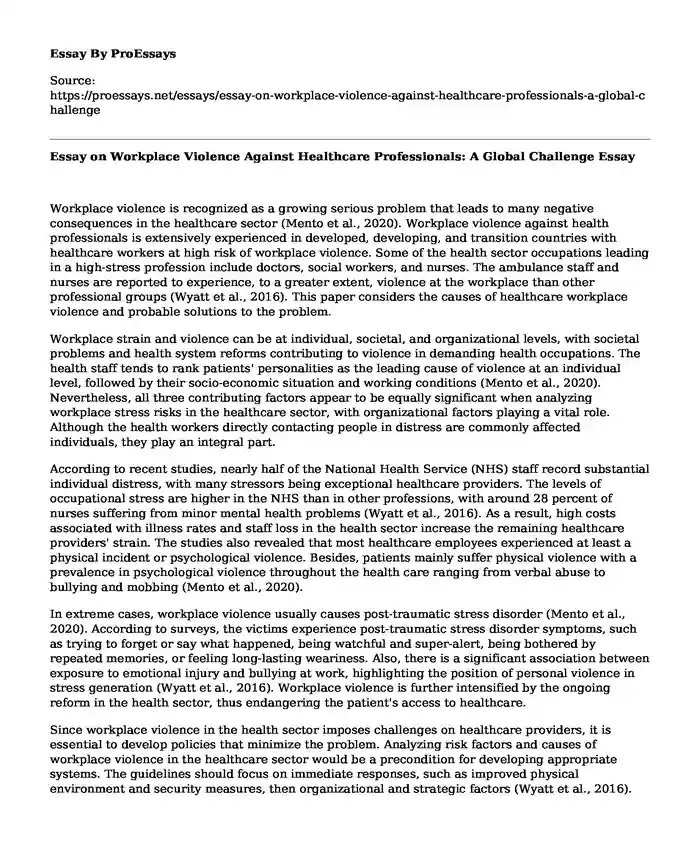Workplace violence is recognized as a growing serious problem that leads to many negative consequences in the healthcare sector (Mento et al., 2020). Workplace violence against health professionals is extensively experienced in developed, developing, and transition countries with healthcare workers at high risk of workplace violence. Some of the health sector occupations leading in a high-stress profession include doctors, social workers, and nurses. The ambulance staff and nurses are reported to experience, to a greater extent, violence at the workplace than other professional groups (Wyatt et al., 2016). This paper considers the causes of healthcare workplace violence and probable solutions to the problem.
Workplace strain and violence can be at individual, societal, and organizational levels, with societal problems and health system reforms contributing to violence in demanding health occupations. The health staff tends to rank patients' personalities as the leading cause of violence at an individual level, followed by their socio-economic situation and working conditions (Mento et al., 2020). Nevertheless, all three contributing factors appear to be equally significant when analyzing workplace stress risks in the healthcare sector, with organizational factors playing a vital role. Although the health workers directly contacting people in distress are commonly affected individuals, they play an integral part.
According to recent studies, nearly half of the National Health Service (NHS) staff record substantial individual distress, with many stressors being exceptional healthcare providers. The levels of occupational stress are higher in the NHS than in other professions, with around 28 percent of nurses suffering from minor mental health problems (Wyatt et al., 2016). As a result, high costs associated with illness rates and staff loss in the health sector increase the remaining healthcare providers' strain. The studies also revealed that most healthcare employees experienced at least a physical incident or psychological violence. Besides, patients mainly suffer physical violence with a prevalence in psychological violence throughout the health care ranging from verbal abuse to bullying and mobbing (Mento et al., 2020).
In extreme cases, workplace violence usually causes post-traumatic stress disorder (Mento et al., 2020). According to surveys, the victims experience post-traumatic stress disorder symptoms, such as trying to forget or say what happened, being watchful and super-alert, being bothered by repeated memories, or feeling long-lasting weariness. Also, there is a significant association between exposure to emotional injury and bullying at work, highlighting the position of personal violence in stress generation (Wyatt et al., 2016). Workplace violence is further intensified by the ongoing reform in the health sector, thus endangering the patient's access to healthcare.
Since workplace violence in the health sector imposes challenges on healthcare providers, it is essential to develop policies that minimize the problem. Analyzing risk factors and causes of workplace violence in the healthcare sector would be a precondition for developing appropriate systems. The guidelines should focus on immediate responses, such as improved physical environment and security measures, then organizational and strategic factors (Wyatt et al., 2016). The victims' support would be a priority in a violent incident by providing psychological and medical assistance and rehabilitation measures.
Conclusion
In conclusion, when health workers feel stressed at work due to work shifts, staff shortages, low pay, transport to work, and other conditions, they may become discouraged and leave the profession, resulting in difficulty accessing healthcare services. Therefore, developing appropriate policies would greatly help in providing solutions to workplace violence in the healthcare sector.
References
Mento, C., Silvestri, M., Bruno, A., Muscatello, M., Cedro, C., Pandolfo, G., & Zoccali, R. (2020). Workplace violence against healthcare professionals: A systematic review. Aggression and violent behavior, 51, 101381. https://onlinelibrary.wiley.com/doi/abs/10.1111/jocn.14683
Wyatt, R., Anderson-Drevs, K., & Van Male, L. M. (2016). Workplace violence in health care: a critical issue with a promising solution. Jama, 316(10), 1037-1038. https://doi.org/10.1001/jama.2016.10384
Cite this page
Essay on Workplace Violence Against Healthcare Professionals: A Global Challenge. (2023, Nov 30). Retrieved from https://proessays.net/essays/essay-on-workplace-violence-against-healthcare-professionals-a-global-challenge
If you are the original author of this essay and no longer wish to have it published on the ProEssays website, please click below to request its removal:
- Advanced Professional Laws and Values of Nurses Essay
- Infant Mortality in Afghanistan Essay
- Ethical Issues in Treating Childhood Obesity Paper Example
- Response to the Article "Why Are Drugs Cheaper in Europe?" Paper Example
- Essay Sample on First Job
- Essay Sample on Healthcare Industry Challenges: Population Growth, Unfunded Care & More
- Free Essay Example on The Fundamental Attribution Error: Exploring the Factors at Play







